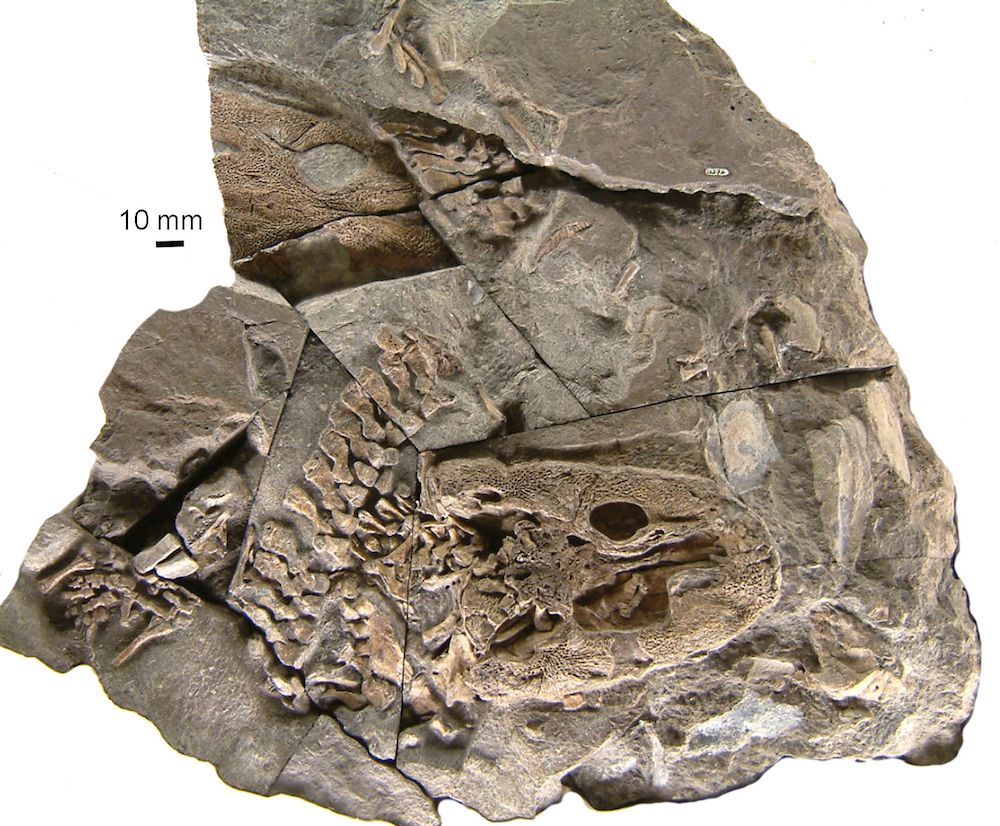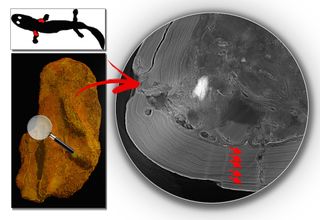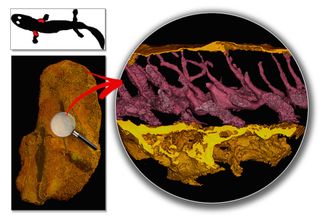Ancient 4-Limbed Creatures Were Too Young for Trip Ashore

Some 360 million years ago, a school of juvenile lizard-like creatures ─ with no parental chaperones around ─ perished in a watery grave in what is now Greenland. That's the story researchers have pieced together from fossils of some of the first four-limbed vertebrates (called tetrapods) to call Earth home.
The finding took researchers by surprise, as they thought that the fossil specimens of the animal, known as Acanthostega, belonged to water-dwelling adults, not young'uns. The discovery raises the possibility that once they matured, these creatures moved to land, but fossil evidence of adults is needed to say so for sure, the researchers said.
Regardless, the discovery is painting a more detailed picture of Acanthostega. Until now, little was known about the life cycle of these early tetrapods, which date to the Devonian period (419 million to 359 million years ago). Some early tetrapods were the first creatures to venture from water onto land, the researchers said. [Top 10 Useless Limbs (and Other Vestigial Organs)]
"Understanding the life history of these early tetrapods, which are iconic transitional forms between fishes and land animals, is of great interest for studying the tetrapod move to land," said lead study researcher Sophie Sanchez, who researches the bones of fossil vertebrates at Uppsala University in Sweden.
To investigate, Sanchez and her colleagues turned to dozens of Acanthostega fossils, which study co-author Jenny Clack, an emeritus professor of vertebrate paleontology at the University of Cambridge in England, found in the remains of an ancient stream in East Greenland in 1987.
When Clack discovered the fossils, researchers assumed that the ancient four-legged creatures were adults.
The new team used high-resolution synchrotron X-ray scans to study the upper arm bones of the Acanthostega fossils. The X-rays taken are similar to ones that doctors take in hospitals, only more powerful, Sanchez said.
Sign up for the Live Science daily newsletter now
Get the world’s most fascinating discoveries delivered straight to your inbox.
"The difference is that the fossils are dense like rock, so we need very powerful X-rays to go through them and get access to the microstructure of the bone," Sanchez told Live Science in an email. "We were able to look at submicron resolution and visualize the cell and blood-vessel spaces."

The X-rays revealed how Acanthostega's blood vessels were organized, which helped the researchers understand the prehistoric animals' biology, physiology and metabolism, Sanchez said.
Furthermore, the X-rays showed the growth rings within the animals' bones. By counting the rings, which are like the rings of a tree, "we could assess the age and the growth rate of these individuals of Acanthostega," she said.
No adults here
Surprisingly, the scans suggested that the Acanthostega specimens represented water-dwelling juveniles that were about 6 years or older when they perished, Sanchez said.

"Their growth had not yet begun to slow down as it does at sexual maturity," she said. "In addition, we showed that Acanthostega's foreleg remained cartilaginous until late during its development. In contrast to bone, cartilage is a non-mineralized tissue, elastic and far too weak to allow the forelegs to sustain the weight of the animal’s body out of the water."
That these creatures still had cartilage suggests that "the Acanthostega mass-death deposit represents a school of aquatic juveniles that included few or no adults," study senior author Per Ahlberg, a researcher at the Uppsala Centre for Evolution and Genomics, said in a statement.
What's more, the Acanthostega fossils still had gills, another sign that they had not yet reached maturity. In living land-dwelling amphibians, larvae metamorphose in the water, and leave only after they have lost their gills.
But it's difficult to say whether Acanthostega ventured onto land once it matured. Without an adult Acanthostega specimen, it's impossible to say whether they were aquatic or terrestrial animals, Sanchez said.
"This means that we need to find the adult fossils before being able to build up theories on the tetrapod move to land," she said.
The study was published online today (Sept. 7) in the journal Nature.
Original article on Live Science.

Laura is the archaeology and Life's Little Mysteries editor at Live Science. She also reports on general science, including paleontology. Her work has appeared in The New York Times, Scholastic, Popular Science and Spectrum, a site on autism research. She has won multiple awards from the Society of Professional Journalists and the Washington Newspaper Publishers Association for her reporting at a weekly newspaper near Seattle. Laura holds a bachelor's degree in English literature and psychology from Washington University in St. Louis and a master's degree in science writing from NYU.












